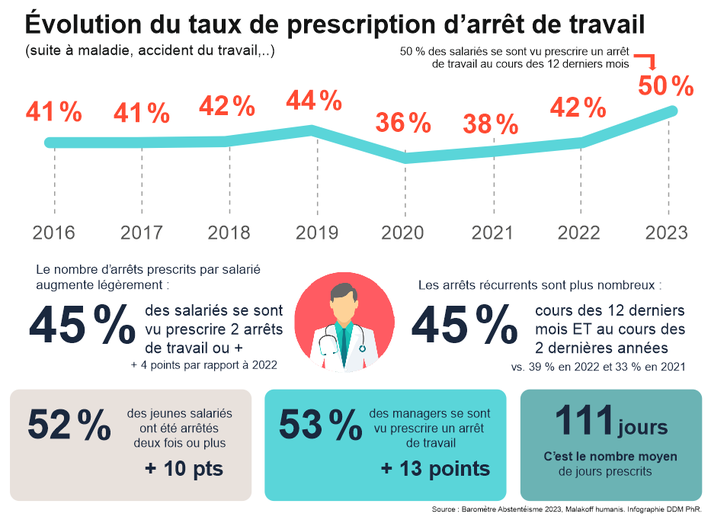The government indicated on Monday that it had identified “at least 10 billion euros in savings” to reduce public debt and deficit until 2027. These savings will have to be found in health, in particular by fighting against the explosion of sick leave. Targeted by the government, general practitioners are angry.
The time for calming relations between doctors and the government has not yet come. Already angry at not having obtained the revaluation of the prices of the consultations under agreement that they demanded, annoyed by the multiple parliamentary initiatives to fight against the medical deserts who want to impose a place of installation on them, the doctors saw open Monday a new front against them: the costly explosion of sick leave that doctors would grant too casually.
Sick leave up 8% in one year
This new blow came from the Minister of Economy and Finance. Eager to definitively turn the page on “whatever it costs”, Bruno Le Maire is chasing expenses. To reduce France’s public debt and deficit until 2027, the government thus indicated on Monday that it had identified “at least 10 billion euros in savings” obtained by cutting in particular in health expenditure. Are in the crosshairs of Bercy “the excesses” of drug spending and the explosion of sick leave, up 8% in one year.
“It represents a total expenditure of 16 billion euros per year. There are sick leaves that are justified: that’s normal, they must be compensated. Then there are abuses. And abuses, they must be controlled, and they must be punished, ”insisted the minister. A few days earlier, the Minister of Public Accounts Gabriel Attal had explained to the Senate that “the annual amount of daily allowances could reach 23 billion euros by 2027, against 14 billion today, if the phenomenon is not not restrained…”
This political will also comes a few days after the Health Insurance launched a recovery campaign, suspecting certain professionals of “complacency”. “If a thousand “strong prescribers” are targeted as a priority, 5,000 treating general practitioners will be summoned to confraternal interviews and 15,000 will receive at least one visit from Health Insurance delegates to warn them of excessive practice… Well heard only general practitioners are in the crosshairs… Nearly a third of general practitioners targeted, that’s a lot! “The MG France union had already protested on June 15, castigating a “brutal” campaign.
Scapegoating doctors?
“Making general practitioners into question as scapegoats when they are already suffering the worst constraints with the decline in their numbers and the coercive laws that threaten, looks more like “toxic management” which could well have the effect of accelerating the fall in the numbers of these professionals no more deviant than others ”, tackled the first union of generalists.
The anger obviously did not subside after the words of Bruno Le Maire. “We have a real campaign of intimidation so that we no longer arrest people who need to be arrested,” said Monday on FranceInfo Agnès Giannotti, president of the union of doctors MG France.

Evolution of the work stoppage prescription rate
To justify its control campaign, Health Insurance has argued that the expense related to compensation for work stoppages “appears very dynamic and accelerating, with a rate of change of 7.4% in 2022, from 6, 6% on average since 2019 (excluding Covid), while it amounted to 4.4% between 2015 and 2019, justifies Health Insurance with our colleagues. Growth in wages and employment alone does not explain this increase in spending”.
One in two employees arrested at least once a year
On the figures side, two barometers support the increase in work stoppages and therefore in compensation expenses. The Mercer barometer indicates that 48% of employees were absent at least once for more than three days in 2022, compared to 36% in 2021 and 39% in 202. The average duration of stoppages has however decreased from 32 to 26 days compared to year two years ago. And yesterday the Malakoff Humanis absenteeism barometer indicated that “with 50% of employees arrested at least once in the year, sickness absenteeism has reached its highest level since 2016.” The barometer also reveals a clear increase in multiple stoppages: 45% of employees who have been stopped in the last 12 months have had at least 2 stoppages (compared to 41% in 2022 and 41% in 2021), a trend confirmed by nearly half of treating physicians.
“Who deregulated? It is the state. Who put the platforms in direct access on ‘my health space’? It is the state. Pointing to general practitioners is absolutely outrageous. The needs for care are increasing, the population is aging, the retirement age is being pushed back, so a responsible politician anticipates these increasing expenses”, retorts on FranceInfo Agnès Giannotti while Luc Duquesnel, president of the “generalist” branch of the Confederation of the French medical unions (CSMF), considered that “putting this pressure on attending doctors is scandalous, it is mistreatment of family doctors”.

